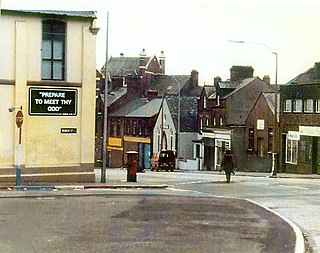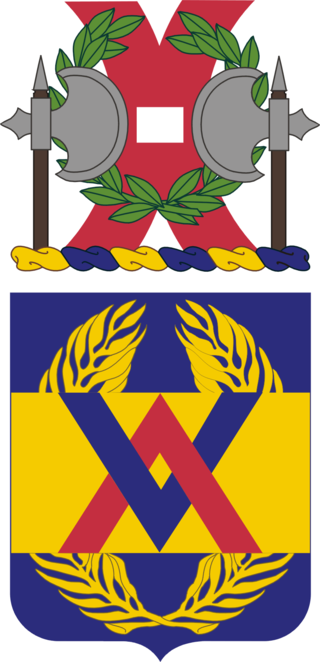
The Israeli Combat Engineering Corps is the combat engineering forces of the Israel Defense Forces.

The Royal New Zealand Army Logistic Regiment, is the New Zealand Army's main military Logistics and combat service support (CSS) element. It is the largest regiment in the NZ Army.

The United States Army Quartermaster Corps, formerly the Quartermaster Department, is a sustainment and former combat service support (CSS) branch of the United States Army. It is also one of three U.S. Army logistics branches, the others being the Transportation Corps and the Ordnance Corps.
A parachute rigger is a person who is trained or licensed to pack, maintain or repair parachutes. A rigger is required to understand fabrics, hardware, webbing, regulations, sewing, packing, and other aspects related to the building, packing, repair, and maintenance of parachutes.

The United States Army Ordnance Corps, formerly the United States Army Ordnance Department, is a sustainment branch of the United States Army, headquartered at Fort Lee, Virginia. The broad mission of the Ordnance Corps is to supply Army combat units with weapons and ammunition, including at times their procurement and maintenance. Along with the Quartermaster Corps and Transportation Corps, it forms a critical component of the U.S. Army logistics system.
An ammunition technician (AT) is a British Army soldier, formerly of the Royal Army Ordnance Corps but since 1993 of the Royal Logistic Corps, trained to inspect, repair, test, store, and modify all ammunition, guided missiles, and explosives used by the British Army. These technicians are also trained to use demolition to safely dispose of individual items of ammunition and explosives (EODs) or to conduct logistics disposal of bulk stocks of multi items. After gaining sufficient experience, those who show the appropriate qualities are given extra training to render safe improvised explosive devices (IEDs) by a process called improvised explosive device disposal. Experienced ATs may be called to give evidence as expert witnesses in criminal or coroner's courts in relation to ammunition or explosives or to EOD and IEDD duties.

An ammunition technical officer (ATO) is an officer involved in all aspects of the army, air force, and navy's use of ammunition. This includes: bomb disposal, clearance of ERW, explosives accident investigation, procurement, in service management, storage, and inspection and repair.

The 7th Engineer Support Battalion is an engineering support unit of the United States Marine Corps and is headquartered at Marine Corps Base Camp Pendleton, California. The unit falls under the command of 1st Marine Logistics Group and the I Marine Expeditionary Force.
11 Explosive Ordnance Disposal and Search Regiment RLC is a specialist regiment of the British Army's Royal Logistic Corps (RLC) responsible for counter terrorist Explosive Ordnance Disposal (EOD), the safe recovery or disposal of conventional munitions. The regiment also has an ammunition inspectorate role supporting the Inspector Explosives (Army). With headquarters in Didcot, the regiment has sub units geographically based throughout the UK to provide a nationwide high readiness response capability in support of the police.

562 Parachute Squadron Royal Corps of Transport (Volunteers) was a minor unit that supported 44th Parachute Brigade (V).

The Royal Australian Corps of Transport (RACT) is a corps within the Australian Army. The RACT is ranked tenth in seniority of the corps of the Australian Army, and is the most senior logistics corps. It was formed on 1 June 1973 as an amalgamation of the Royal Australian Army Service Corps (RAASC) and Royal Australian Engineers Transportation Service. The RACT is responsible for the operation of army surface transport assets, movement control, terminal and postal services, and Army aspects of air logistic support.
The 68th Division Sustainment Support Battalion is a U.S. Army support battalion stationed at Fort Carson, Colorado. The Battalion motto is "Stagecoach, LET'S GO". The 68th Division Sustainment Support Battalion's current call sign is "Stagecoach". The 68th DSSB has deployed overseas to India, Burma, Somalia, Cuba, Kuwait, Saudi Arabia, Iraq, and Afghanistan.
The 7th Combat Service Support Battalion is an Australian Army administration and logistics battalion which provides transport, supply and maintenance support services to units of the 7th Brigade. The battalion is made up of both Regular personnel and has recently been involved in deployments to Timor Leste, Iraq and Afghanistan.
The Northern Army Group (NORTHAG) was a NATO military formation comprising five Army Corps from five NATO member nations. During the Cold War NORTHAG was NATO's forward defence in the Northern half of the Federal Republic of Germany (FRG). The Southern half of the Federal Republic of Germany was to be defended by the four Army Corps of NATO's Central Army Group (CENTAG). During wartime NORTHAG would command four frontline corps and one reserve corps. Air support was provided by Second Allied Tactical Air Force.

The 264th Combat Sustainment Support Battalion is a U.S. Army support battalion stationed at Fort Bragg, North Carolina. The Battalion motto is "Support for Victory". The 264th has deployed overseas to France, Vietnam, Haiti, Nicaragua, Guatemala, Afghanistan, and Iraq.
From four Stores Depots in the main centres of New Zealand at the beginning of the 20th century, the Royal New Zealand Army Ordnance Corps (RNZAOC) expanded and shrank to meet the operational needs of the NZ Army, Ordnance units have been deployed worldwide and across the breath and width of New Zealand.
142nd Division Sustainment Support Battalion is a multifunctional logistics headquarters. It is task organized as a Division Sustainment Support Battalion with capability required to support specified mission requirements. The CSSB supports echelon above brigade units, multifunctional brigades, functional support brigades, and brigade combat teams. The CSSB may support Army special operations forces as part of their area support task. The 142nd DSSB is currently stationed at Fort Bliss, Texas, and is a subordinate unit of the 1st Armored Division Sustainment Brigade.
A Combat Sustainment Support Battalion (CSSB) is a combat service support battalion of the United States Army. A CSSB can be attached to a sustainment brigade to support the brigade combat teams and support brigades assigned to a corps with maintenance, transportation, supply, field services, and distribution functions. The CSSB is task-organized with the subordinate units necessary to carry out its mission.
Future Soldier is a reform of the British Army resulting from the Integrated Review of Security, Defence, Development and Foreign Policy published in March 2021. The aim of the reform is to create a more lethal, agile and expeditionary force, able to fight and win wars and to operate in the grey-zone between peace and war. Future Soldier was published on 25 November 2021 and deals with the organizational changes of the British Army, with changes to personnel and equipment were set out in the Defence in a Competitive Age paper published on 22 March 2021.









